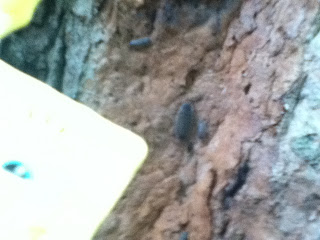Thursday, September 15, 2011
Climax community
This community of trees represents a climax community because the species mix of the forest is dependent on the abiotic factors that are exclusive to this region. Factors fount in the temperate deciduous forest like the one in the photo. (light, temp., rainfall, fertility, and depth of soil)
This community of trees represents a climax community because the species mix of the forest is dependent on the abiotic factors that are exclusive to this region. Factors fount in the temperate deciduous forest like the one in the photo. (light, temp., rainfall, fertility, and depth of soil)
Exponential growth
These bugs are the ideal type of species for exponential growth. Because they are an R-selective species they can rapidly reproduce. If there was a large amount of available resources the bugs ability to multiply large quantities quickly, would be the ideal situation for exponential growth.
These bugs are the ideal type of species for exponential growth. Because they are an R-selective species they can rapidly reproduce. If there was a large amount of available resources the bugs ability to multiply large quantities quickly, would be the ideal situation for exponential growth.
Principal Exclusion Principal
The principal states that no two organisms can exploit the same niche at the same time. One can see this in the way that Adenosine is bullied and abused by Charaf (seen stomping on Adenosine's back). The two turtles are both trying to live in the same tank and live off of the same food pellets at the same time, because of this there is competition. Clearly Charaf is the better sued animal, and if it weren't for the deliberate feeding of Adenosine by you (Ms.Maddox) and other class mates, Adenosine; as the principal implies... would surly die.
The principal states that no two organisms can exploit the same niche at the same time. One can see this in the way that Adenosine is bullied and abused by Charaf (seen stomping on Adenosine's back). The two turtles are both trying to live in the same tank and live off of the same food pellets at the same time, because of this there is competition. Clearly Charaf is the better sued animal, and if it weren't for the deliberate feeding of Adenosine by you (Ms.Maddox) and other class mates, Adenosine; as the principal implies... would surly die.
Limiting factor
This pineapple is food; food is a limiting factor for environments because the amount of food available determines the amount of organisms that can sustain life. Too manny organisms combined with too little food causes deaths. A population can not grow in size if there is not enough available food.
This pineapple is food; food is a limiting factor for environments because the amount of food available determines the amount of organisms that can sustain life. Too manny organisms combined with too little food causes deaths. A population can not grow in size if there is not enough available food.
Carbon cycle
This demonstrates the carbon cycle because the decomposition of dead organisms deposits carbon into the soil. Meaning that this pile of dead wood will eventually be broken down into manny things, on of which will be carbon. That carbon will then be deposited into the soil thus contributing to the carbon cycle.
This demonstrates the carbon cycle because the decomposition of dead organisms deposits carbon into the soil. Meaning that this pile of dead wood will eventually be broken down into manny things, on of which will be carbon. That carbon will then be deposited into the soil thus contributing to the carbon cycle.
 Distribution Pattern: Clumped
Distribution Pattern: ClumpedThese mushrooms were found all along the forest floor, but they grew in clumped groups of three or four.
Tuesday, September 6, 2011
Subscribe to:
Comments (Atom)


















